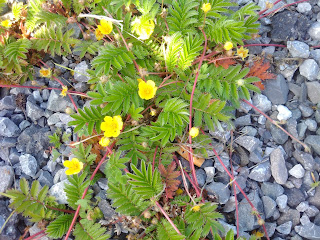I thought I discovered a new species! A hybrid between a strawberry and a buttercup plant. It thrived along Newfoundland roads amongst the gravel like a strawberry, with its long red extenders linking plant to plant. Bright, shiny, waxy buttercup flowers beamed up from frothy leafs. But alas! While it most likely is the result of cross species pollination, it has existed for hundreds of years. It's like biscotti all over again.
The roots of my discovery were boiled, dried and used by Aboriginal North American tribes as a medicine plant or winter food, this plant is now called Cinquefoil or Silverweed, (not to be confused with Shrubby Cinquefoil which was typically a source for tea.) It yields a high amount of vitamins and minerals, despite my fear it might be poisonous, given the buttercup contains toxins, which eaten in large quantities can be fatal. Leaves, and flowers were not used.
Today, there are commercial versions of strawberry tea. It is important to remember that wilted strawberry leaves contain a chemical that can interfere with your blood's ability to clot. Only use fresh leaves when making home brewed tea.
The roots of my discovery were boiled, dried and used by Aboriginal North American tribes as a medicine plant or winter food, this plant is now called Cinquefoil or Silverweed, (not to be confused with Shrubby Cinquefoil which was typically a source for tea.) It yields a high amount of vitamins and minerals, despite my fear it might be poisonous, given the buttercup contains toxins, which eaten in large quantities can be fatal. Leaves, and flowers were not used.
Today, there are commercial versions of strawberry tea. It is important to remember that wilted strawberry leaves contain a chemical that can interfere with your blood's ability to clot. Only use fresh leaves when making home brewed tea.



No comments:
Post a Comment